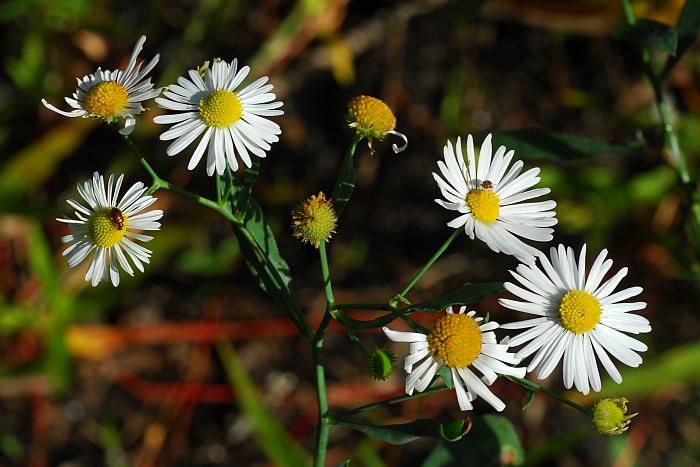Boltonia asteroides (L.) L'Hr.
False Aster

Native
CC = 4
CW = -3
MOC = 59
© SRTurner
Boltonia asteroides (L.) L'Hr.False Aster | |
 |
Native CC = 4 CW = -3 MOC = 59 |
© SRTurner |
|
Family - Asteraceae/Astereae Habit - Robust perennial forb, fibrous-rooted, with basal offshoots and elongate rhizomes, sometimes somewhat woody at the base Stems - Ascending to erect, to 1.5 m, usually well-branched in the upper third, ridged, glabrous.
Leaves - Alternate, simple, 2-15 cm long, 4-25 mm wide. Basal leaves absent at flowering, narrowly oblanceolate to oblong-obovate. Stem leaves mostly sessile, progressively reduced toward the stem tip, the blades oblanceolate to elliptic or linear, bluntly to sharply pointed at the tip, tapered to long-tapered at the base, the margins entire or minutely toothed, the surfaces glabrous, the bases not decurrent.
Inflorescences - Large branched panicles, the heads solitary at branch tips, the branches with numerous leafy bracts, these 1.5-5.0 cm long, 2-6 mm wide.
Heads - Radiate, relatively large, the receptacle usually 6-14 mm in diameter at flowering. Involucre 3-5 mm long, the bracts in mostly 3 subequal series.
Florets - Ray florets 25-60, pistillate, the corolla 7-15 mm long, white. Disc florets 60-180, perfect, the corollas yellow. Pappus of disc florets a short, irregular crown of awns or narrow scales 0.1-0.4 mm long and usually 2 awns 0.5-2.0 mm long, the longer awns mostly well developed in the disc florets, often absent in the ray florets.
Fruits - Achenes, dimorphic, 1.5-3.0 mm long, the wings 0.1-0.5 mm wide. Fruits developing from the disc florets wedge-shaped to obovate in outline, relatively strongly flattened, broadly rounded or angled to shallowly notched at the tip, the margins winged, the surface and margins often minutely hairy, tan to grayish brown with lighter wings; fruits developing from ray florets more or less wedge-shaped, 3-angled, with 3 narrow wings. Flowering - July - October. Habitat - Streambanks, pond margins, bottomlands, sloughs, fens, marshes, fields, ditches, also moist, sandy disturbed areas. Origin - Native to the U.S. Lookalikes - Boltonia decurrens; more distantly, members of the Erigeron genus. Other info. - This tall and showy and showy member of the aster family is common throughout much of Missouri, though it is curiously uncommon or absent in much of the Ozark region. Its U.S. distribution comprises a wide band in the Midwest and eastern Plains states, and extending from the Gulf border into Canada. The flower heads are aster-like and can potentially be confused with other members of the family. The foliage of Boltonia is distinctive, however, with leaves which are very smooth and usually with a pronounced bluish tint. Photographs taken at Shaw Nature Reserve, Franklin County, MO, 9-15-2006, 9-20-2007, and 9-28-2018, Otter Slough Conservation Area, Stoddard County, MO, 7-18-2009, and Marais Temps Clair Conservation Area, St. Charles County, MO, 9-1-2022 (SRTurner). |